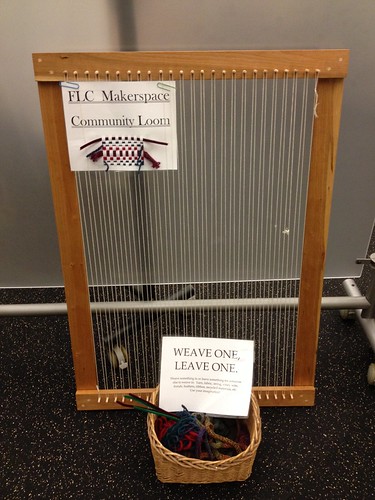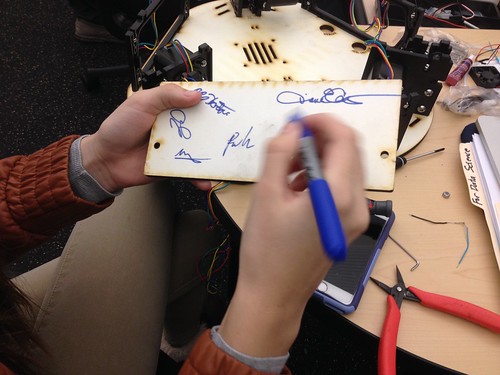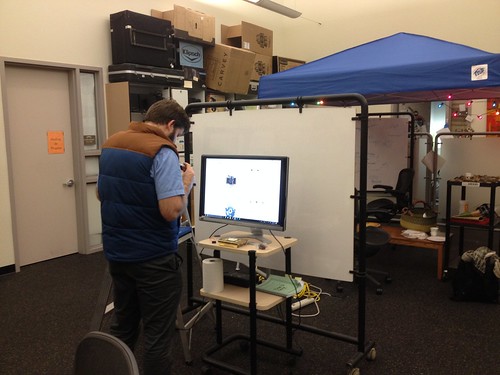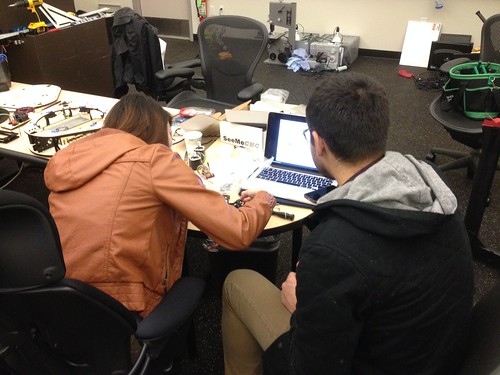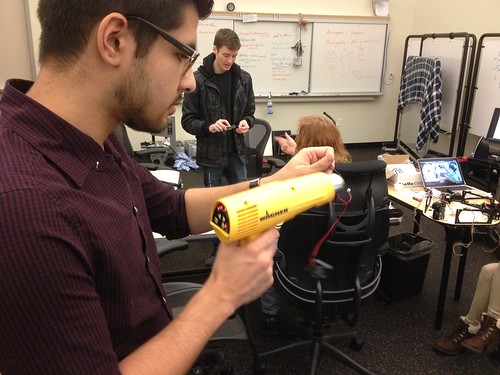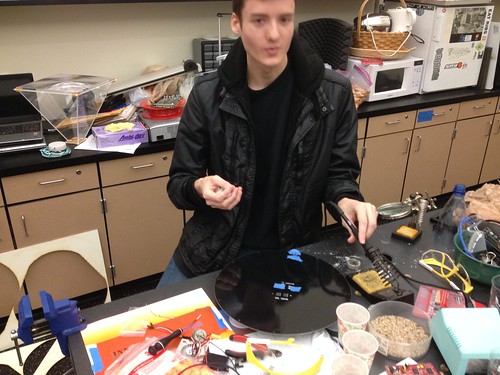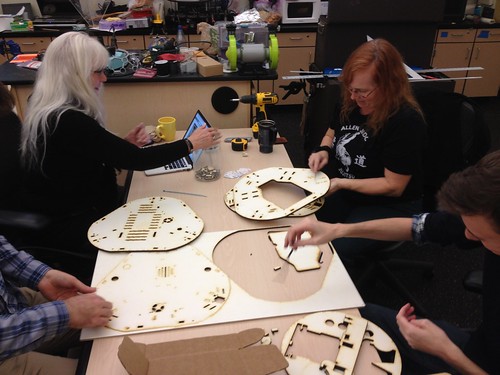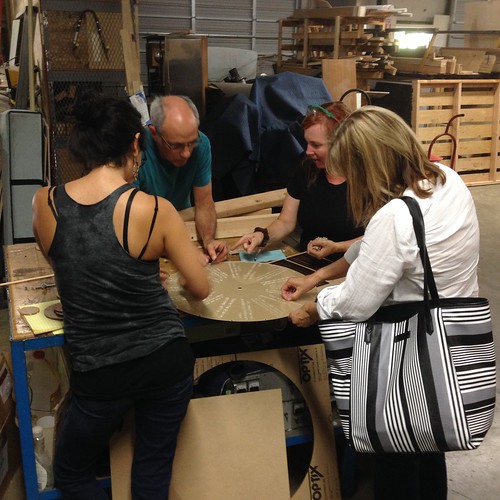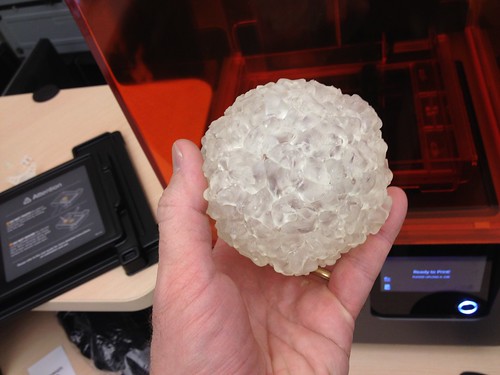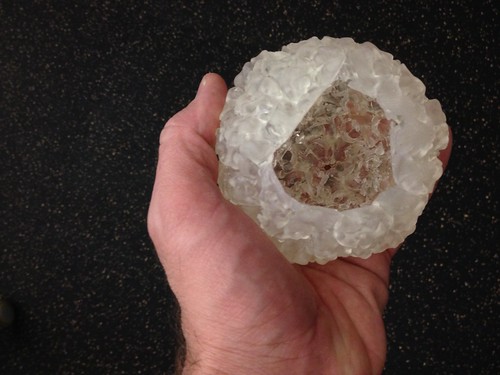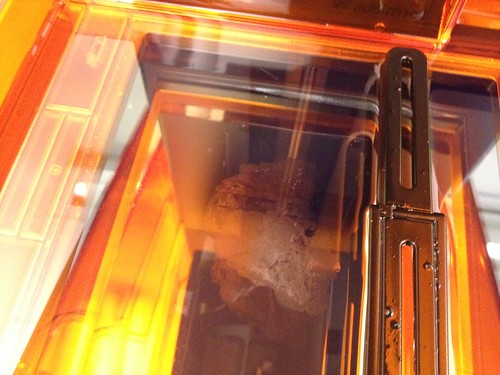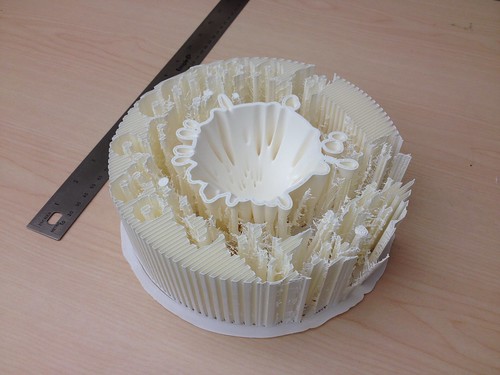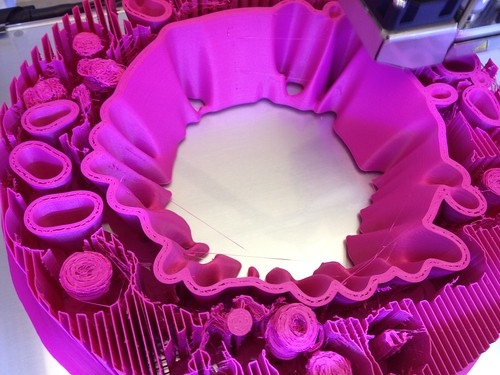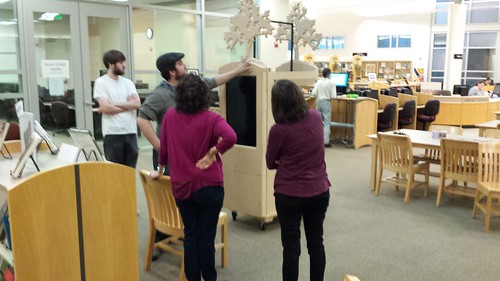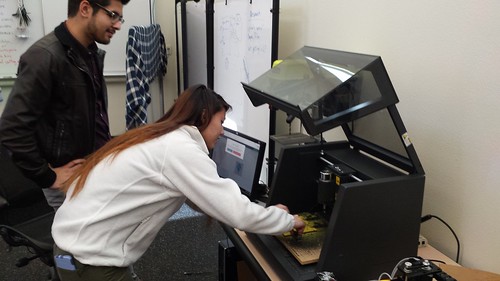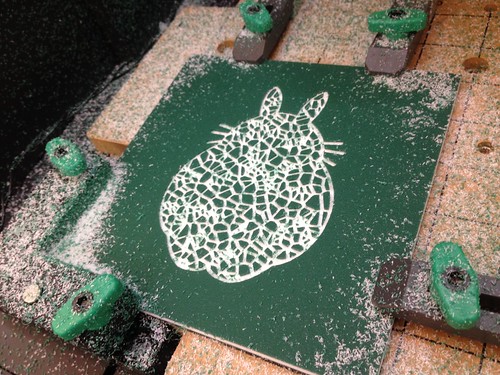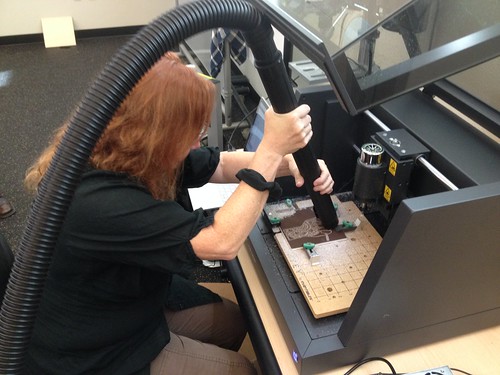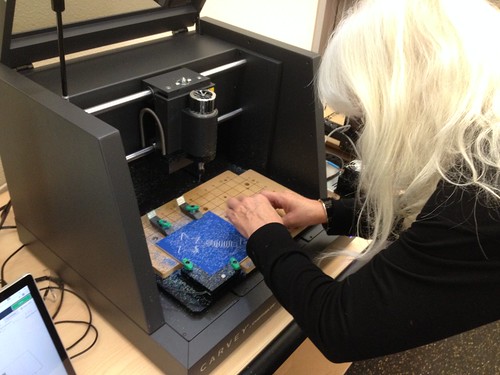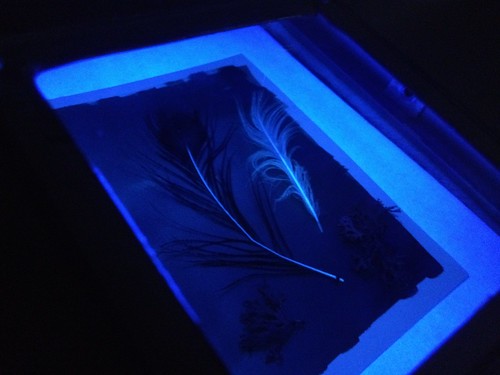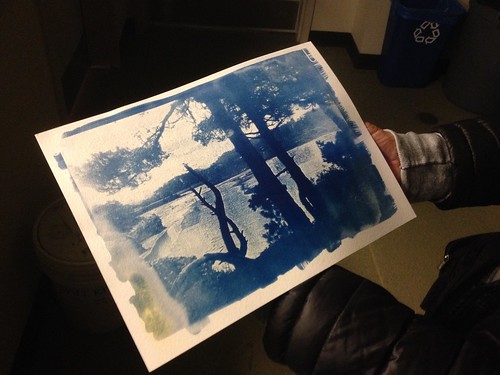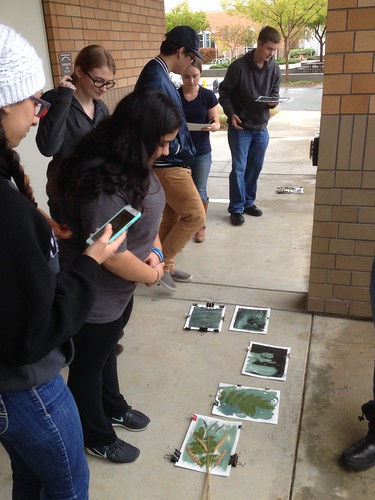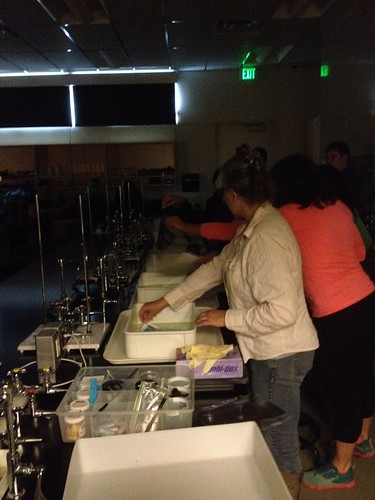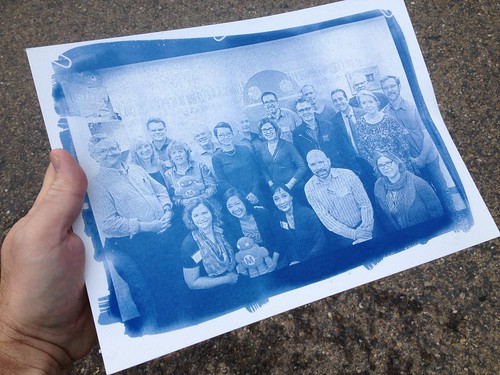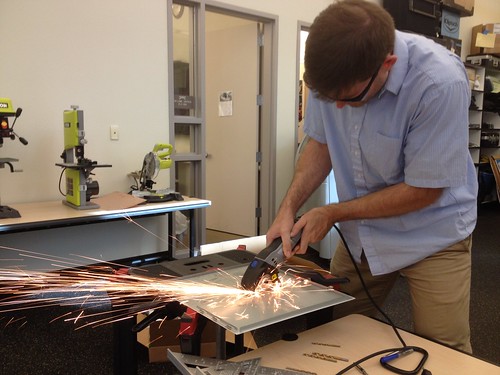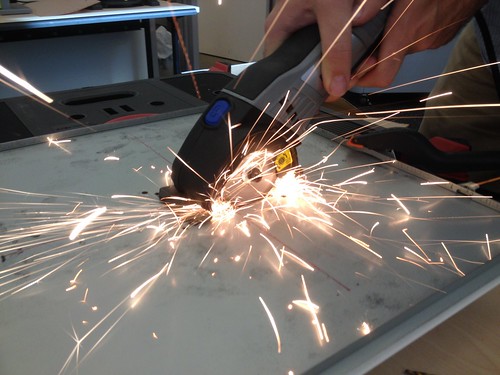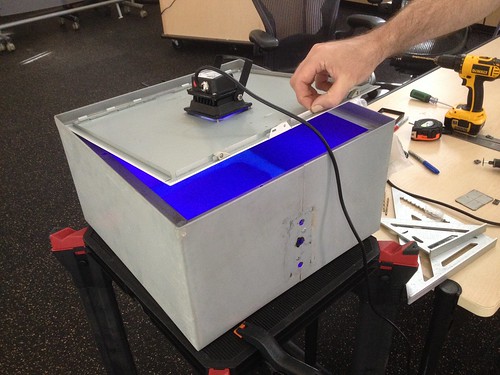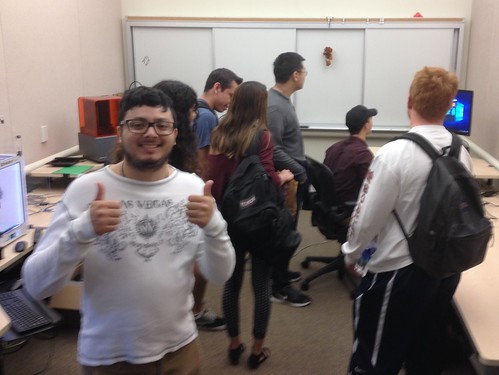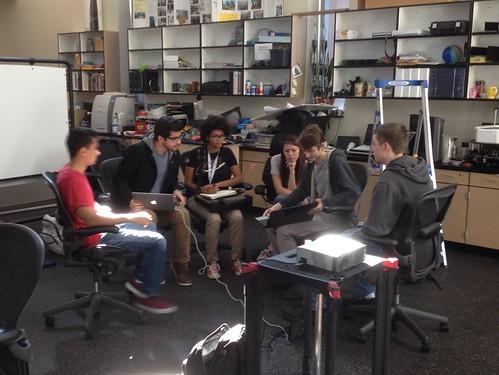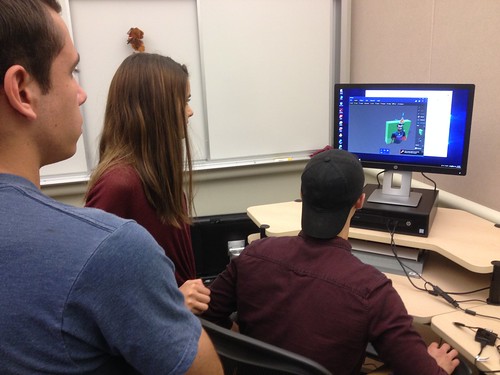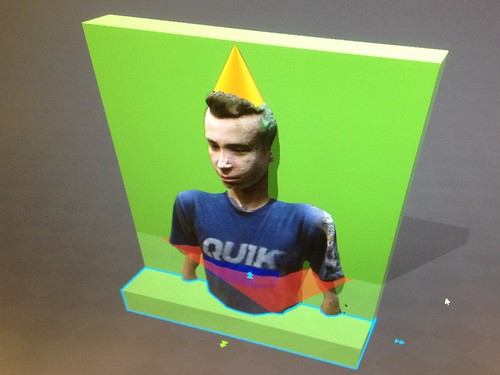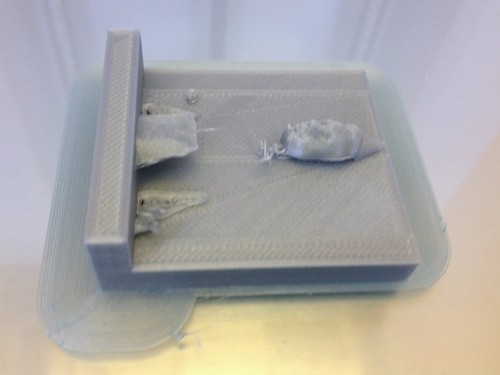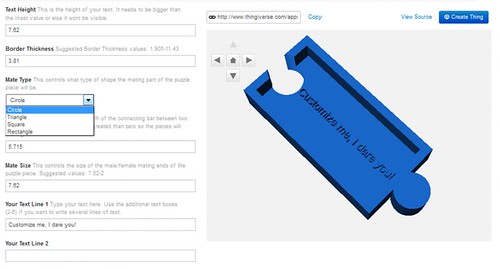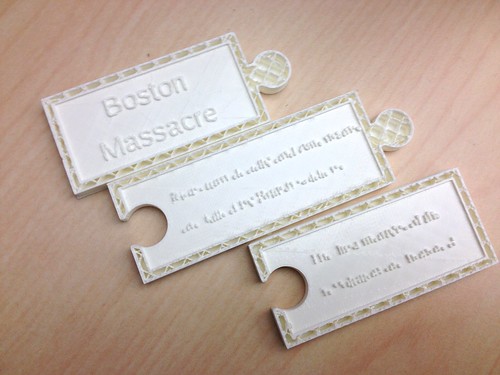Walked in this morning to find this!
Hosted the second Rostock Max build day today. The crew – mostly the same folks from the first build day – put in a good day of work, and we got much of the hot end done, finished up the base, and made good progress on the top assembly. We decided to adapt the topping out tradition, aka “signing the beam,” though we aren’t actually finished with the build.
More photos from today’s build…
Spent the better part of today building – or starting, anyway – the Rostock Max v3. There’s tremendous cultural and social value in having folks take ownership of their tools. We ordered this 3d printer in DIY kit form specifically so that we could build it together, following our successful building/bonding experience putting together the X-Carve (part 1, part 2, part 3). Champion maker educators Diane Carlson (Sociology), Jennifer Kraemer (Early Childhood Education), and Max Mahoney (Chemistry) were were joined by students Nathaniel Adams, CJ Costa, and Alex Hartigan.
It sometimes takes a while to get rolling on a complicated build. I’ve learned that one of the best ways to kick things off is to get all the participants doing something communal and simple, so we started by collectively picking out all the little bits left over from the laser cutting process. A low risk/high reward opportunity for the group to gel, visit, socialize, and quickly develop a common purpose.
This kind of social busywork seems to scratch some shared primate itch, and reminded me of my favorite moment from last summer’s Making Across the Curriculum workshop, during which folks gathered around to chat and pick the protective paper off of Diane’s Wheel of Voting Rights project.
That finished, we loosely divided up the work and got to building. With this particular build, there are a lot of steps that can be completed independently and in no particular order – in other words, not a lot of serial dependencies – so folks were able to dive in and work in pairs and trios without (usually) having to wait for others to finish. Despite a few missing parts (which turned out not to be missing after all), we made a good start, and will continue building later in the week.
Some significant failures recently in the 3D printing department. Inspired by Steve Holzberg’s (Biology) cancer prints, Linda Abraham (Biology) found a model of a rhinovirus for printing. Given the complexity of the model, and the intricately folded surface detail, we decided the Form 2 was the printer to use. Loaded up the clear resin and let it print. The result:
Mostly it worked fine, but the top of the model had problems. A strange rupture appeared in the sphere:
The anomaly coincided with, was caused by – or maybe left? – this cloudy residue in the tray:
The tray was fresh out of the wrapper, and it was the very first run of clear, so I’m not sure exactly what caused the failure. In any case, the model is still perfectly usable, after a little filing to smooth out the jagged edges of the rip.
Meanwhile Max Mahoney (Chemistry) and Alex Hartigan (Student) continue to work on their 3D printed free energy surfaces project. After something like 84 hours, the intricate nested conical structure, our largest print to date, began failing, and we pulled the plug on it to regroup (with 105 hours left on the print).
The center part of the model printed beautifully, and after some careful calculations to determine where things went wrong, Max set out to print the remainder of the model – in pink, since we ran out of white filament – with the idea of gluing them together somehow.
This one too is failing out on the margins. Support material configured as a tower seems to be the common failure point. Stay tuned…
With the fall show winding down, Cameron and the Theater Arts crew are trying to get the aquaponics system wrapped up, and brought the near-finished display up to the library for a dry-fitting.
I’m told they’ll have it buttoned up within a week, after which all the other work – getting the tank established, setting up and calibrating all the sensors, connecting all that to the network, figuring out the display and the giant “get tank vitals” arcade button – can continue in earnest.
We’re also close to getting the nine tiles for the first pane of the Carvey project finished, inspired by Jeff Solin’s Mosaic Tile project. Nathaniel and Rebekah of FLC’s Data Science Club carved up a version of their club logo to add to the other faculty and student tiles we’ve got so far.
The plan then is to mill (on the big ShopBot down in Theater Arts) a 3×3 tile “waffle” frame, with recessed wells for each of nine tiles. That will comprise the first of hopefully many such 9-tile collections, as additional faculty, staff and students create their own tiles, and all that work will be on display, either outside or inside of the Innovation Center.
Finally got a chance to put the cyanotype UV boxes we worked on over the last couple of weeks into production! Max Mahoney (Chemistry), Christa Oberth (Chemistry), and Heike Schmid (Art) organized a Science Center activity working with students to produce cyanotypes. Following Max’s explanation of the process and the chemistry involved, and Heike’s discussion of the art history side of the equation, everyone got to work, some preparing paper by painting it with the sensitizer solution, others drying the still wet paper with a hairdryer, and others arranging materials and printing negatives.
Some students used feathers, leaves, and other object to create beautiful photograms, seen here through the UV filtering viewing panels Max and I built into the boxes…
…while others printed negatives on transparency film and used those to expose the photosensitive solution-treated paper.
A lot of folks showed up, so some used the exposure boxes, and others used good old fashioned sunlight to expose their prints.
About 16 minutes in the boxes, or longer in the sun, and the prints were ready for a rinse, and some optional post-processing in a bath of hydrogen peroxide (which was supposed to enhance the prints, though students were divided on whether it really did much at all), or tea or coffee (for a sepia look).
I took the opportunity to reproduce a group photo from yesterday’s CCC Maker Advisory Committee.
Lots of ideas about how to improve the boxes – bigger, more LEDs, etc. – but very pleased with the version 1 results, and really pleased also to see faculty working on interdisciplinary projects!
Chris (student) dropped by the IC today, and we spent a little time making improvements to the Kinect scanning process we first piloted earlier in the week. Specifically, we put the Kinect on a tripod, and Chris sat on a rotating bar stool and spun himself around. As expected, the result was a much more accurate and complete model.
Brandon (student and Math & Engineering Club president) has some ideas about developing some motion systems for more accurate scanning, and I’m going to talk to Marisa Sayago (Art) about scanning and reproducing some student art. This is turning into a fun project, and one that students definitely seem to enjoy!
Max Mahoney (Chemistry) and I spent much of today building out some cyanotype exposure boxes for an upcoming Science Center activity. The boxes are re-purposed lighting fixtures. For the lids, we used the removable access panels from old Gateway desktop computers I had stored in the closet years ago, cutting them in various ways to mount two different styles of UV LED lights that will be used to expose the prints.
Next steps include installing some handles in the lids, adding some kind of reflective treatment – foil or silver metallic spray paint? – to the inside surfaces, and creating viewing windows with UV filtering acrylic to allow students to monitor the progress of their prints.
Had the opportunity to work with students from FLC’s Math & Engineering Club this afternoon. In a conversation some weeks back, Brandon (club president) and I discussed using the XBox Kinect sensor as a 3D scanner, something I’ve been wanting to do since last semester, but have not had the time to get going. I let Brandon know that I had two such sensors in the lab – the 360 version and the newer XBox One version – and so we arranged to meet today to go over the process. Brandon as it turned out brought the whole club.
They set to work scanning one of their colleagues, along the way learning things about object placement, lighting, and the Skanect software. Meanwhile, the newly-formed Data Science Club met in the main lab to talk about an app they’re designing.
While Brandon worked on cleaning up the scan of Chris, I walked the other students through changing filament on the Ultimaker and setting up a print job in Cura.
Brandon ended up doing the Han Solo frozen in carbonite treatment to deal with some weirdness on the back of the scan, in the process adding a party hat. I let Chris do the honors of starting the print, and then we set up OBS Studio to stream the print job to YouTube so that the M&E students could monitor progress remotely.
As it turns out, the model didn’t quite print correctly, so there’s some work to do there, but isn’t that why we prototype?
This was the first of hopefully many chances for the M&E Club to work in the Innovation Center, and I’m looking forward to finding ways to plug students in to various projects, in the mold of the History game tiles project.
Sat down the other day with student Alex Hartigan (he of the Calculus III models) to talk about designing an OpenSCAD version of Gena Estep’s (Professor of History) History game tiles. After talking it through, Alex went off and did an incredible job creating a very flexible version of the model that can be configured in lots of ways in the Thingiverse Customizer. Alex is the kind of student who doesn’t do things half way, and so of course he created four different possible “Mate Types” for connecting the various pieces.
As with most things, version one needed a little tweaking. Specifically, as is often the case in digital fabrication, size and scale needed to be worked out, and Alex was able to quickly adjust the default sizes of the text and other elements so that they were more likely to print successfully without a bunch of post processing.
This project is one model of the kind of faculty/student collaboration I’m trying to foster. Too often good ideas never see the light of day because of assorted limitations, be they time or resources or skills. In this example, Gena had a great idea, and Alex was able to bring that idea to life in a way that enables relatively easy production. To close the loop, Gena has found a student who is interested in doing the work in Thingiverse to configure and download the various game pieces and print them. It’s my hope that the relationships we’ve been building between the Innovation Center and especially interested students – from the Math & Engineering Club for instance, and the Data Science Club and Science Center – will lead to many more examples of these kinds of projects and partnerships.

